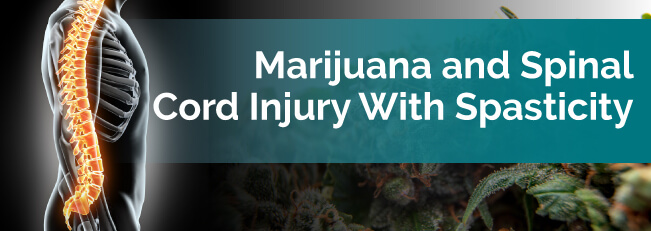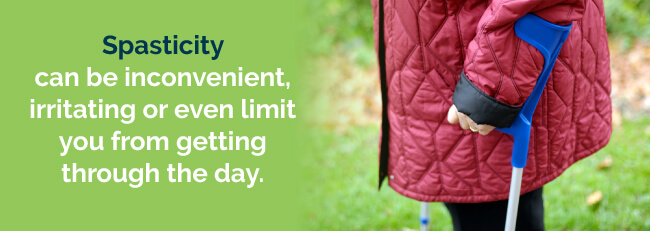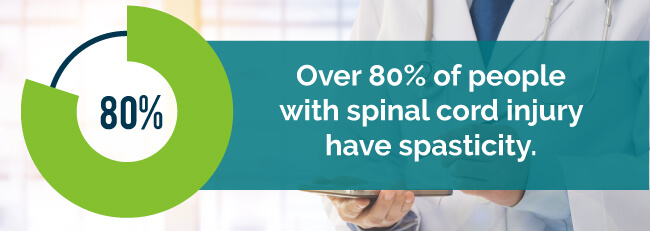
Spinal cord injuries, which involve the crushing or compression of your spinal cord, can occur after a traumatic blow. They can cause severe pain, muscle spasms, stiffness, depression, neurological damage and, in many cases, spasticity. Marijuana and spinal cord injury with spasticity treatment can help manage these and other symptoms of this condition.
Spasticity is a condition where your muscles contract or tighten uncontrollably. It’s common for people with spinal cord injuries or who have damaged the part of the brain that controls voluntary movement.
Your brain and spinal cord nerves form a complex message circuit that commands movement of your body. Information on processes or sensations, such as muscle stretch or touch movement, is sent to your spinal cord and then up to your brain. In response, your brain interprets these signals and sends your spinal cord necessary commands telling your body how it should react.
Your body reaction, such as yanking away from an object that’s hot, is a reflex that happens automatically and quickly. After you injure your spinal cord, however, it can disrupt the normal flow of these signals, making it so the message isn’t sent to your brain. Instead, these signals are sent back to your spinal cord’s motor cells, causing a reflex muscle spasm that may involve jerking, stiffening or twitching of your muscle.
Just about any movement, irritation or touch can trigger and sustain muscle spasms. Common muscle spasm triggers include:
Spasticity can be inconvenient, irritating or even limit you from getting through the day. But there are treatments for the condition, including medical marijuana.

In the journal Neurosurg Focus, Austin Colohan, M.D., and Jason Lifshutz, M.D., describe the history of spinal cord injury, spastic paralysis, and their therapies, dating back for thousand years. For over a millennia, spinal cord injuries (SCI) have been devastating. The first known description of this injury came in the 17th century BC from the ancient Egyptian Edwin Smith papyrus, which said it was not treated. Hindu texts from 1800 BC mention SCI and describe traction methods for straightening the spine.
Andre Louis, a surgeon in 1762, took out a bullet from a patient’s lumbar spine, and the patient later regained motion in their legs. Surgeon Gilpin Smith performed a laminectomy procedure in 1829 that was successful in improving a patient’s spasticity-related sensation. There was an over 80 percent mortality rate in 1934 in the first couple years after a spinal cord injury, usually because of pressure sores and urinary tract infections.
Breakthroughs in medical care, imaging, surgery and rehabilitation medicine and significant SCI care improvement didn’t occur into the latter part of the century. Since the mid-20th century, the relative occurrence of complete compared to incomplete injuries, described below, has improved, due mostly to the insistence on better and faster primary care and stabilization of patients with spinal cord injury. Partial credit for this improvement has been given to setting up professional emergency medical services to get people to the hospital.
SCIs are divided into two categories, incomplete and complete. Those with incomplete injuries have partial function loss that varies in degrees of severity. Complete is where you lose total function below the area of injury.
SCI patients often experience symptoms of spasticity following a course of spinal shock and poor quality of life due to their symptoms. Spasticity as a syndrome in the spinal cord injury population isn’t always managed effectively, despite its prevalence. This is probably because the syndrome can have a variety of presentations, with each of them having their own etiology.
Symptoms of spinal cord injury spasticity may include:
You may also experience:
Spasticity makes it so your body can’t coordinate and control muscle movement. As a result, you may experience symptoms such as:
Spasticity can influence your quality of life negatively through:
As the statistics show, spasticity with spinal Cord Injuries are common. Statistics from the journal Neurorehabilitation and Neural Repair and reported by the National Institutes of Health reveal:

Statistics from the journal Nature show:
Like paralysis, spasticity is extremely unpredictable. While some injured people recover completely, others don’t improve at all. Some people only experience modest changes in their level of spasticity.
At present, there’s no way of reversing damage to the spinal cord. However, there are treatment options, including immobilization, medication, and surgery. Treatment focuses on preventing further injury and helps patients manage pain and other undesirable symptoms.
For many paralyzed individuals, spasticity also occurs. The method of treatment depends on several factors, such as:
Talk with your doctor and see what your treatment options are. Some common treatments include the following.
Physical therapy helps prevent shortening or shrinkage of a muscle, or joint contractures, and reduces your symptom severity. Some physical therapy options that can help you maintain flexibility and reduce spasticity and your risk of permanent joint contractor include:
There are other physical therapy treatments you can talk over with your doctor.
When your spasticity under control with physical measures, you may need medication. Some medications may include the following.
If you experience spasticity in vast areas of your body, your physician may prescribe you any of the following medication:
Common side effects of these oral medications include:
The effectiveness of these types of medication varies for each individual. Your doctor carefully monitors you when you take any of these medications because of their side effects.
If only certain areas of your body have spasticity, your doctor may inject anesthetic medications, phenol, alcohol, or neurotoxins like botulinum toxin into your muscles affected with spasticity. You’ll only benefit from temporary relief from these injections, so you must repeat the injections several times a year. Your doctor may give you these injections exclusively or combine them with oral spasticity medications.
Common side effects of nerve blocks may include:
Your doctor may recommend intrathecal medication therapy, also called a baclofen pump. Intrathecal medication therapy uses a battery-powered and surgically placed pump with a catheter attachment to deliver the medication straight into your spinal canal, or intrathecal space, around your spinal cord.
Just like multiple sclerosis (MS), SCI may cause pain that cannabis for spinal cord Injury with spasticity treatments can help relieve. Cannabis sativa and its derivatives also treat the spasticity found in SCI. Additionally, as with MS, you’ll likely require long-term medical care with SCI. Medical cannabis shows promise in this area as well.
Medical weed has a few side effects, which include:
Most people tolerate the side effects of medical pot with no problem.
In a recent study, it was found that cannabinoids could be used to help patients who have found that other therapeutic measures have been insufficient in treating the symptoms of spasticity associated with chronic spinal cord injury.

Various studies point to the effectiveness of medical marijuana for the treatment of spasticity and spinal cord injuries. A study published in the Archives of Physical Medicine and Rehabilitation was conducted to evaluate the perceived weed effects on SCI spasticity. Forty-three questionnaires of people with SCI allowed researchers to compile data that suggested that marijuana for spinal cord injury with spasticity treatment decreased spasticity in SCI patients.
Another study, published in the Journal of Spinal Cord Medicine, involved 117 participants with traumatic SCI aged 18 years or older with chronic pain. It showed most of their pain relief came from massage and medical cannabis use.
After administering cannabinoids shortly after a spinal cord injury, the cannabinoids stimulate the neuroprotective responses and limit the damage, according to a study published in PLoS One. Early endogenous CB1 and CB2 receptor activation following SCI is a protective response involved in recovering spontaneously.
To date, patients with a quality spinal cord injury with spasticity condition are eligible for medical marijuana in Illinois and New York. Severe and/or persistent muscle spasms are also a qualifying condition for medical marijuana in a number of states. Patients in other states should work with their medical marijuana doctor to determine if their debilitating condition qualifies for medical cannabis.
Whole-plant extracts of THC, CBD or a matched placebo were given to 18 spinal cord injury patients through a sublingual spray in a preliminary controlled study. The doses given were based on titration against unwanted effects or symptom relief inside a range of 2.5-120 mg every 24 hours.
The study results revealed THC improves many of the symptoms of SCI, including:
Both CBD- and THC-associated pain relief was substantially better than the placebo. The study’s conclusion revealed the medicinal extracts could improve neurogenic symptoms that don’t respond to traditional treatments. Unwanted effects are typically well tolerated and predictable.
Not only have studies shown that CBD has incredible painkilling properties, but it also helps improve motor function and spasticity in in patients with SCI. This incredible diversity of symptoms relief to spinal cord injury patients is thanks to the medicinal compounds of cannabinoids found in weed.
As you can see, medical marijuana, even in its raw form, can provide you with safe relief of your SCI symptoms. You may also find relief if you spasm due to your SCI. Muscle spasm, along with pain, is a common reason medical cannabis for spinal cord injury with spasticity is prescribed and recommended by doctors.
There are a number of medical marijuana strains that could provide you with relief from your spinal cord injury with spasticity symptoms. Below are just some standout cannabis and spinal cord injury with spasticity strains you could consider.

You can feel better when you suffer from SCI. To find relief from your spinal cord injury with spasticity symptoms and improve your quality of life, search for a medical marijuana doctor or dispensary.
Find A Doctor Find A Dispensary